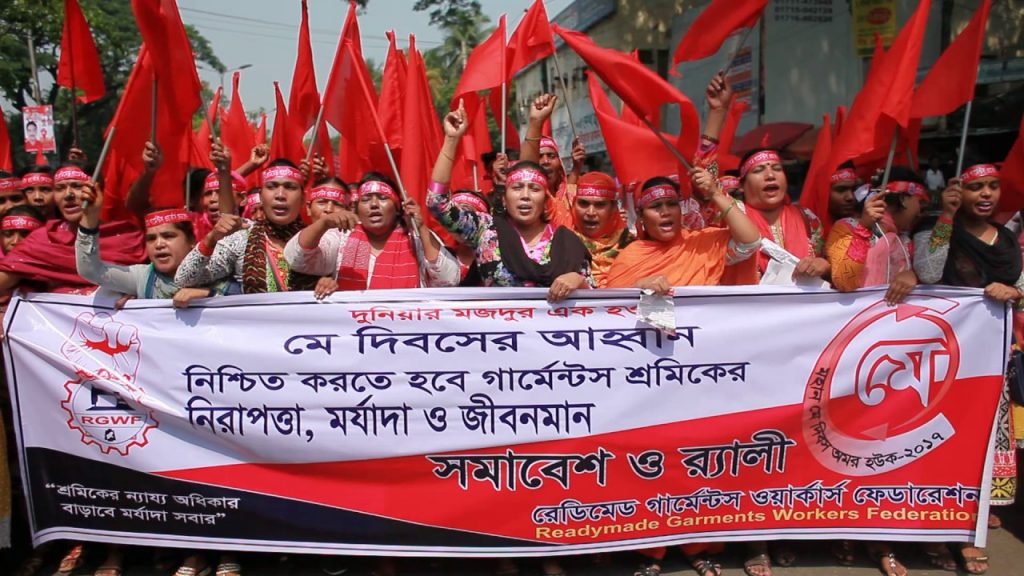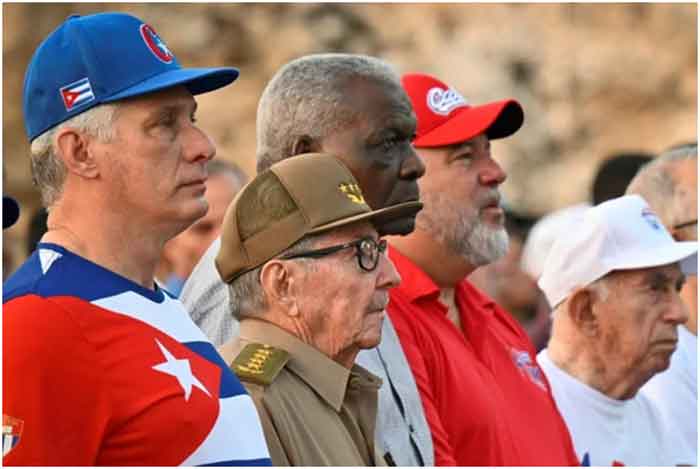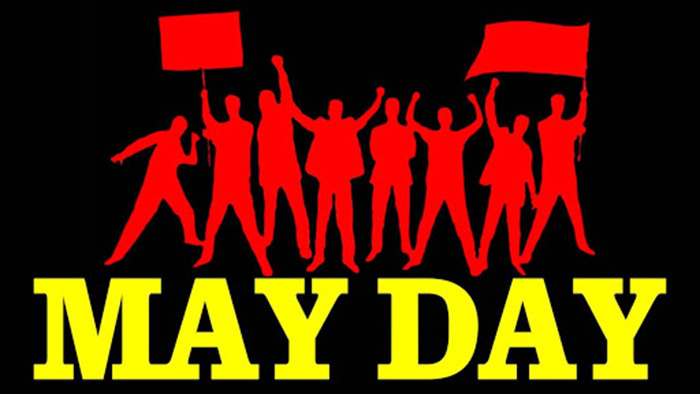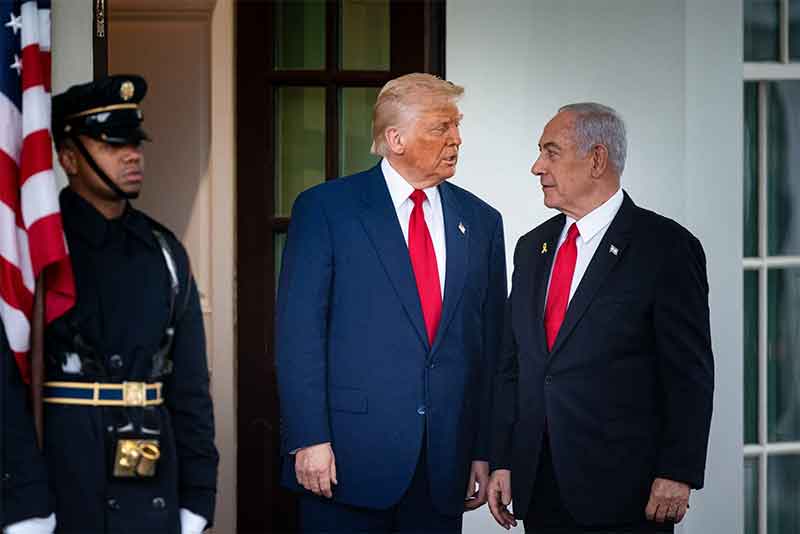
Today is May Day – a day for the labor to celebrate, a day to vow for carrying forward its political struggle for emancipation of humanity, a day to reiterate its position on the questions of capital and capital’s political power; and a day to learn from the working people’s history of struggles.
This land – Bangladesh – is rich with labor’s heroic struggles. The flaring-1969 was one of those days that carry stories of the Bangladesh labor’s dedication for building up a humane society.
Haidar Akbar Khan Rano, member of the presidium of the Communist Party of Bangladesh, in a recent interview [yet unpublished] recollected two incidents that stand as evidence of the labor’s heroic moves.
The incidents
Haidar Akbar Khan Rano, a firebrand student and labor leader, tells:
“It was mid-1969-Bangladesh. [Today’s Bangladesh, at that time was identified as East Pakistan, a province of Pakistan; and the disposed Baangaalee people were waging a long political struggle against the Pakistani rulers.] Martial law led by Pakistan army chief General Yahiya Khan was in full gear. The extra-constitutional rule prohibited public meetings, strike, etc. political actions. The martial law authority awarded harsh punishments including rigorous imprisonment, whipping and fine to student and labor leaders for any act deemed by the authority as a violation of their rule. However, we [unions under the leadership of Rano and his comrades] were carrying on a movement of industrial workers at Tongi, a major industrial area at the outskirts of Dhaka, at that time a provincial capital. The demand of the movement was increase of wages. All workers of all the textile mills adopted a new tact, as their movement was not yielding their desired result. They decided not to accept wages if their demand for new wage rate was not implemented. During the period, minimum wage rate at textile mills was Rupee, currency of that time, 72. After the denial of receiving of wages, the workers began Production Slow Down (PSD). Under trade union laws/acts, PSD is a punishable offence. Workers argued: Our consumption has declined, as wages don’t reach us, which, in turn, makes weaken our bodies; consequently, our capacity to produce decreases. As a result, production fell down to 25 percent. However, other costs of the mills owners, i.e., administrative and electricity costs, remained as usual. The situation was resulting big loss for the owners.
“Our trade union was very strong, disciplined and united. All the mills in the area faced similar situation; and the owners of those mills turned helpless. They approached the martial law authority. Lt. Col. Akabbar Hossain, the district martial law administrator of Dhaka, entered the Meghna Textile Mills, which was owned by Adamjee, one of the 22 families gripping the entire economy. Four armed sepoys accompanied the military officer. They arrested four mill workers immediately after entering the factory premise.
“Like a spark, another incident developed. But, we were not prepared for the development. Even, we had no such plan. The heroic workers made free the arrested workers. That was an action carried within minutes. Moreover, the workers confined the Pakistani military officer and his sepoys in a room, and snapped telephone connection to the room.
“I [Rano] and Kazi Zafar Ahmed [the leader of the communist faction Rano belonged to, and later a prime minister under an autocrat] were at a market place, which was about a kilometer from the place of occurrence, the Meghna Mills. The news reached us. We immediately planned our approach to the incidence of resistance. We discussed with leading mill workers. It transpired in the discussion that the situation didn’t support the incident of confining a martial law administrator; so, a compromise was to be made; but the compromise was to be done with a show of our force, and not losing any part of our strength. It was decided that Kazi Zafar would enter into discussion with the authority while I would mobilize workers from other mills. The mobilization would be in front of the Meghna Mills; and the mobilized workers would join by striking their work in respective mills.
“It was noon, about 2 p.m. Within an hour, our message reached all the mills at Tongi. The workers stroke their work; and assembled in front of the Meghna Mills. I and other labor leaders began delivering speeches at the mobilization. We had no information about discussion Kazi Zafar and the Pakistani colonel were having. As time passed, the colonel and the four sepoys came out of the room. A beaming Kazi Zafar also emerged. He announced that the colonel promised not to arrest either those four or any other worker; and military wouldn’t arrest anyone in this way.”
Haidar Akbar Khan Rano’s recollection cites another development:
“It was end-February, 1969. We began gheraao, seize, movement at Tongi. The first gheraao [also spelled gherao] movement in Bangladesh, at that time it was East Pakistan, began at Olympia Mills at Tongi. That was a scene seen-never-before. Workers were in control of the mills. We could enter the mills after the movement ensued. That was a strange development as these mills were off-limits to us before the movement. In mills and factories, during the movement, owner/manager/representative of owner was confined in a room with provision for ordinary food and water; they were conceding to demands raised by the workers and signing agreements; and increased wages in cash were handed over to the workers. After completion of the process, those bosses were allowed to leave factory premise. Suspended/dismissed labor leaders were reinstated to their jobs; and before to their reinstatement, their all dues were paid in cash. The workers hoisted red flags, the standard of the exploited, in factory premises. This was the gheraao movement.
“This gheraao movement spread at Tongi and its surrounding areas. There was a mix of spontaneity and a bit of organized effort. Kazi Zafar and I had no time for taking food, rest, sleep.
“The gheraao movement spread out to different industrial areas of Bangladesh.”
These are tales of heroic struggle by the industrial workers in Bangladesh during the days of neo-colonial Pakistani rule. These struggles were part of democratic struggle.
The background, in brief
A background to the struggle, no doubt, was there. From the end of November, 1968 Maulaanaa [also spelled Maulana] Bhasani, President of National Awami Party (pro-Peking faction) called upon the poor peasantry to gheraao the corrupt local level officers in charge of infrastructure development work and the land revenue offices. In many places, this seize-movement began from December. The movement initiated in rural areas had its impact on the working class in industrial areas and the gheraao movement turned out as a regular incident, almost daily, from first week of March 1969.
State authorities told the width and intensity of the movement:
“Bhashani remained busy in his gherao, jalao [burn down] and agitation. His leftist and communist workers exhibited least enthusiasm for dialogue and called for unrelenting protest. [….] Political situation deteriorated further with the failure of the RTC [Round Table Conference, a dialogue between all political parties convened by Ayub, the ruler of Pakistan, to diffuse the turmoil tearing down the state]. It was reported to Ayub Khan that civil administration in the East Pakistan was rendered ineffective. Groups of communists and terrorists on the prompting of Bhashani were raiding police stations and houses of Muslim Leaguers. They were compelling Basic Democrats to resign from their membership. In consequence most of the civil officers left their homes and returned to West Pakistan.” (Graig Baxter, ed., Diaries of Field Martial Muhammad Ayub Khan: 1966-1972, Oxford University Press, Karachi, 2007, cited in Himayatullah, Pakistan National Awami Party: Nature and Direction of Politics, dissertation submitted to the Faculty of Social Science for the degree of Doctor of Philosophy in History, Department of History, Quaid-i-Azam University, Islamabad, 2015)
“The tactic of gherao virtually crippled the administration of the province. The strategy was used against the corrupt government officials in the rural areas. Civil machinery was paralyzed in East Pakistan by similar method of force and intimidation. The government was unable to control the widespread law and order situation. (Himayatullah, op. cit.)
For a period of almost five months, from early November 1968 to the end of March 1969, Tariq Ali says, there was a radical uprising all over Pakistan. It involved some 10 to 15 million people across both East and West Pakistan. (The Duel: Pakistan on the Flight Path of American Power, Scribner, Simon & Schuster, New York, 2008) The people of Bangladesh vigorously took part in this democratic struggle; and the working classes were the main force that thrust the movement forward.
“[N]ot a day passed”, writes Herbert Feldman, “without some kind of civil disturbance, riot, strike, bloodshed, or demonstration.” (From Crisis to Crisis: Pakistan 1962-9, Oxford University Press, 1972)
Labor unrest, Feldman observes, “fiercely erupted”; and, it was so great and forceful that “labour was totally out of hand. By means of the gherao and other violence, it demanded and secured promises of increased wages and other amenities”. (ibid.)
Feldman tells:
“The time came when scarcely a factory, commercial establishment or workshop was not aflame with meetings, demands, agitation, and threats of violence and strikes. It is not an exaggeration to say that there was a point at which it seemed possible that economic breakdown might become complete.” (ibid.)
“The movement which workers had taken into their own hands”, press reports said, “was clearly not amenable to control through legal procedures and formalities.” The exploiting classes and their allies, broadly the upper classes, fuelled the force. Tariq Ali cites that fact:
“The upper classes led an existence which bore no relationship to that of the rest of society. While workers on strike were being shot dead on the orders of bureaucrats and capitalists, the latter’s wives were attending expensive fashion parades at luxurious international hotels […]” (Can Pakistan Survive? The Death of a State, Penguin Books, 1983)
It was a show of a small coterie’s indifference to human life, and its indulgence with private property, luxury and luscious life style, leading to inconsideration and brutality, the old stylemark of the exploiting classes.
Along this slimy show of the rich, iron rule forced down the labor.
“While the Ayub Khan era in the 1960s led to rapid industrialization and increased the industrial labour force considerably, it also witnessed retrogressive labour laws. The ban on the right to strike under the Industrial Dispute Ordinance of 1959 weakened the labour movement and hindered the protection of workers’ rights. Furthermore, the imposition of a compulsory adjudication system – normally taking years in litigation from one court to another – deprived workers of their due right to share the profits of industry through collective bargaining.
“A tripartite labour conference was convened in May 1969. Consequently, the government admitted to past failures and announced a new industrial relations policy in July 1969. The new Policy said that ‘the Government was aware that the previous labour policies had failed because adequate machinery for their implementation had not existed. Every step would therefore be taken to ensure that this Policy was supported by the necessary machinery for its implementation.’
“[….]
“Nevertheless, the Policy did not achieve its stated objectives and goals – its failure was primarily due to inadequate enforcement.” (Sabur Ghayur, Evolution of the Industrial Relations System in Pakistan, ILO, Cornell University ILR School, 2009; emphasis added.)
On the opposite, the exploitation of the labor was in full swing.
“Until 1969, the government helped supply industry with cheap labour by suppressing trade union activity. This kept real wages constant or declining until the strikes at the end of the Ayub regime in 1969.” (Angus Maddison, Class Structure and Economic Growth, India and Pakistan since the Moghuls, Routledge, 2006; emphasis in the original.)
The exploiting classes were reaping their “hard earned income”. The following figures on production tell the extent of exploitation, the exploiters’ method of “hard earning”:
“Production in the modern industrial sector increased by 15 per cent a year from 1950 to 1966. Mill-made cotton cloth expanded from 86 million yards in 1947 to 739 million in 1966. Jute goods rose from virtually zero to 404 thousand tons in 1966, cigarettes from 320 million in 1949 to 32 billion in 1966, sugar from 35 thousand tons in 1947 to 417 thousand in 1966. Tea was the only real manufacturing industry which had existed at partition, and it grew much more slowly from 49 thousand tons in 1947 to 67 thousand in 1966.
“From 1949 to 1968 the output of small-scale industry increased 60 percent, whereas output of large-scale industry increased twelve-fold.” (ibid.)
From large- to small-scale industries, wheels of appropriation were revolving at super-fast speed, which is exploitation, more exploitation, intensive exploitation; although a group of scholars find “increased productivity” in these gains by owners of capital, a gain made by thrashing, taming and chaining labor. The small-scale industry-story tells the spread of exploitation the concerned capital spanned.
So, the force the gheraao movement gained is evident from the facts mentioned above, an appropriate opposite reaction by the exploited to the actions by the exploiters.
Anyone concerned with the labor and its power can draw a few primary conclusions from this part of the Bangladesh labor’s struggle, which was heroic and powerful, independent and assertive. It challenged the state machine although in terms of age and experience, the labor was comparatively younger, which is another aspect of the dynamics of the struggle.
Farooque Chowdhury writes from Dhaka















































